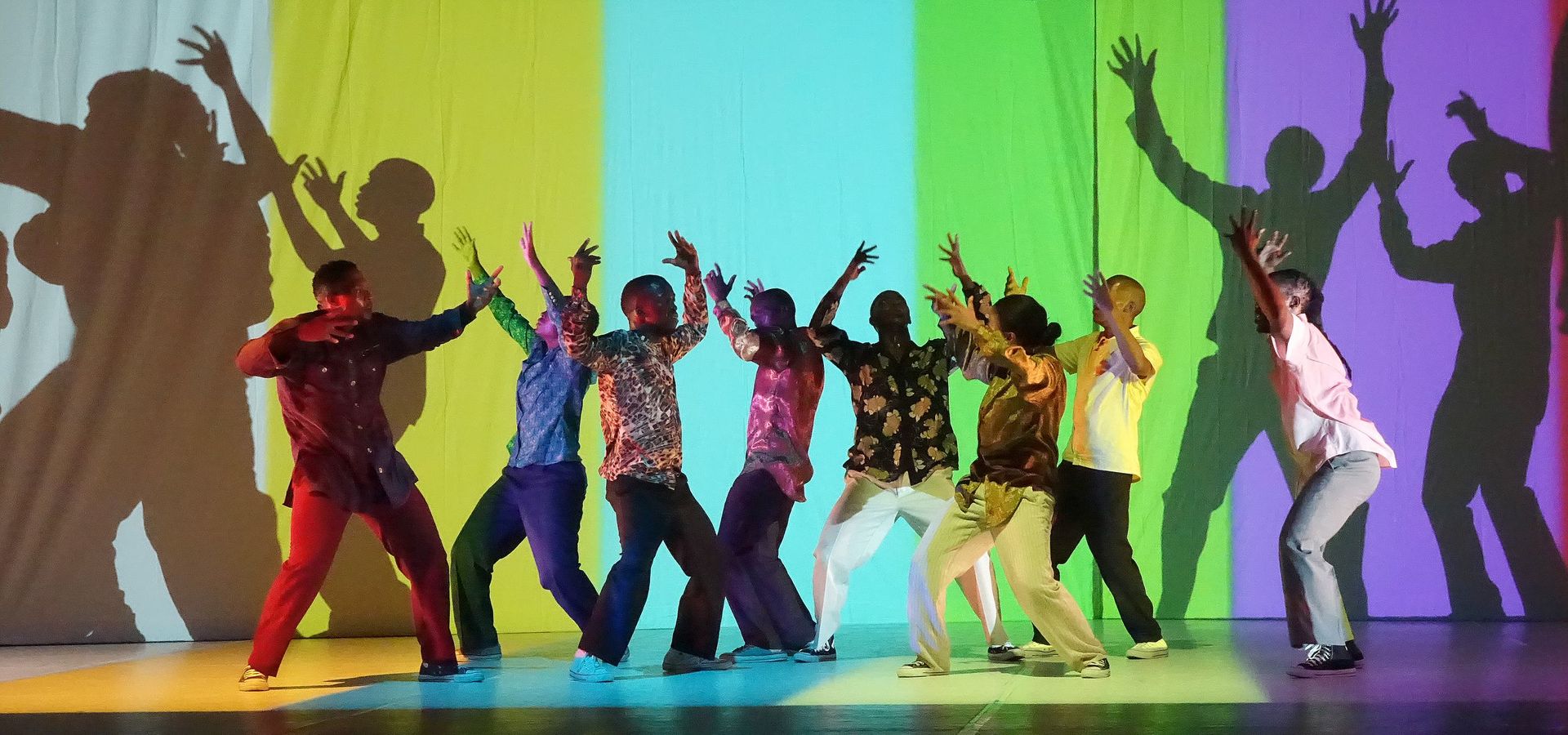
Via Injabulo
-
zo 3 jul20:30 - 21:30Grote Zaal
-
ma 4 jul20:30 - 21:30Grote Zaal
In de dertig jaar van zijn bestaan is Via Katlehong Dance uitgegroeid tot wereldwijde festivalhit. Voor de nieuwste creatie Via Injabulo ging de dansgroep een samenwerking aan met twee aan de weg timmerende Europese dansmakers, Amala Dianor en Marco da Silva Ferreira. Beiden maakten een eigen werk waarvoor ze grif gebruikmaakten van het immense potentieel van Via Katlehong: het aanstekelijke dansplezier van de acht dansers en de pulserende ritmes uit de townships.
Via Katlehong Dance is genoemd naar de township in de Zuid-Afrikaanse Oost-Rand waar het in 1992 als gemeenschapsproject is begonnen. Jongeren worden uitgedaagd om met hun muziek en dans expressie te geven aan hun harde leven. Met een niet mis te verstane optimistische boodschap: een betere wereld ís mogelijk.
Aan de basis ligt de pantsula, een ultra-energieke dans die is ontstaan tijdens het apartheidsregime. De kracht van Via Katlehong is dat de groep op een vernieuwende manier de pantsula met andere dansen combineert, zoals tap, step en gumboot, de ‘mijnwerkersdans’ gebaseerd op slaan op de dijen en de kuiten. Maar de pantsula is veel meer dan dans alleen; het is een levensstijl gevat in mode, muziek, gebarencodes en taal waarmee de jongeren van de townships zich identificeren en uiten.
Voor het eerste werk in Via Injabulo, førm Inførms onderzoekt Marco da Silva Ferreira de betekenis van dans in de sociale context, hoe die kan leiden tot een collectieve identiteit. Pantsula, house dance en andere streetdancestijlen worden geshaket tot een heerlijke cocktail van pulserende energie. In Emaphakathini, put de Frans-Senegalese choreograaf Amala Dianor uit de persoonlijke geschiedenissen van de performers om grenzen tussen mensen én dansdisciplines op te heffen. Doel is om een gemeenschappelijke nieuwe ruimte te creëren, een 'tussenruimte’, oftewel Emaphakathini in Zoeloe.
Het resultaat is één groot feest van opzwepende ritmes en gedeelde energie. Schreeuwen, fluiten, stampen met de voeten, klappen in de handen: iedereen mag meedoen. Sterker: het is onmogelijk om op je stoel te blijven zitten.
ENGLISH
‘A crushing performance, extremely dynamic, intense, with a great driving rhythm’ (Theaterkrant).
After seeing Via Katlehong Dance at Julidans 2018, the critics made no bones about it: anyone who goes to see a show by this dance group from the South African townships is in for a theatrical experience that will linger in the mind for a long time.
In its thirty years of existence, Via Katlehong Dance has grown into a worldwide festival hit. For the latest creation, Via Injabulo, the dance group entered into a collaboration with two leading European dance makers, Amala Dianor and Marco da Silva Ferreira. Both made a work of their own for which they made eager use of the immense potential of Via Katlehong: the infectious dancing pleasure of the eight dancers and the pulsating rhythms from the townships.
Via Katlehong Dance is named after the township in South Africa's East Rand where it began as a community project in 1992. Young people are challenged to express their hard lives through their music and dance. With a message of unmistakable optimism: a better world is possible.
The basis is formed by the pantsula, an ultra-energetic dance that came into existence during the apartheid regime. Via Katlehong's strength is that the group innovatively combines the pantsula with other dances, such as tap, step and gumboot, the 'miner's dance' based on hitting the thighs and calves. But the pantsula is much more than just dance; it is a lifestyle encapsulated in fashion, music, gesture codes and language with which the youth of the townships identify and express themselves.
For the first work in Via Injabulo, førm Inførms, Marco da Silva Ferreira explores the meaning of dance in the social context, how it can lead to a collective identity. Pantsula, house dance and other street dance styles are shaken into a delicious cocktail of pulsating energy. In Emaphakathini, Franco-Senegalese choreographer Amala Dianor draws on the personal histories of the performers to pull down boundaries between people and dance disciplines. The aim is to create a common new space, an 'in-between space', or Emaphakathini in Zulu.
The result is one big feast of rousing rhythms and shared energy. Shouting, whistling, stamping your feet, clapping your hands: everyone can join in. In fact, it is impossible to remain sitting on your chair.
**** '(...) the head rolls, tap dance, body percussion and foot rolls not only carry an explicit, readable and honest message, but also a hint of hope.' - de Volkskrant about Via Kanana, Julidans 2018
‘Een verpletterende voorstelling, extreem dynamisch, intens, met een geweldig stuwend ritme’
Nagesprek / After talk zo / Sun 3 juli
Gesprek met / with: Amala Dianor en Marco Da Silva Ferreira
Credits
Choreography
First part Amala Dianor
Second part Marco Da Silva Ferreira
Dancers Thulisile Binda, Julia Burnhams, Katleho Lekhula, Lungile Mahlangu, TshepoMohlabane, Kgadi Motsoane, Thato Qofela and Abel Vilakazi
Music tbc
Light design Cárin Geada
Stage management Alexander Farmer
Project directors Buru Mohlabane and Steven Faleni (Via Katlehong)
Booking Damien Valette
Coordination Louise Bailly
production Via Katlehong Dance, Damien Valette Prod
Co-productions (in progress) Maison de la Danse - Lyon, Théâtre de la Ville - Paris, ChaillotThéâtre National de la Danse, Festival DDD - Teatro Municipal do Porto, Le Grand T - Théâtre deLoire Atlantique, Créteil - Maison des Arts, Festival d'Avignon
Thanks to the City of Ekurhuleni Sport, Recreation, Arts and Culture Department


